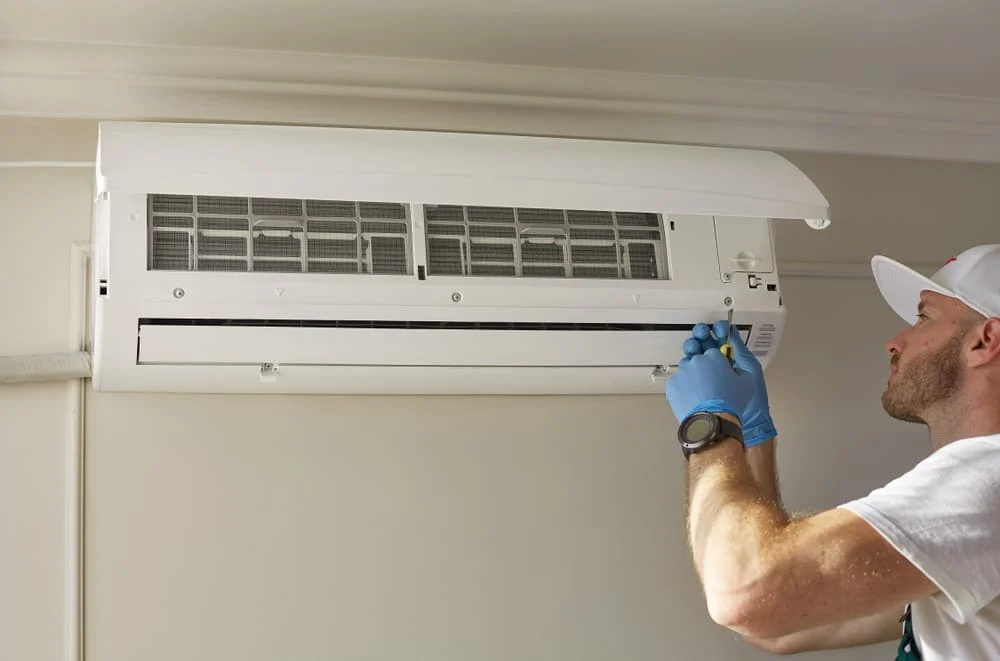The lifespan of your air conditioner may potentially be shortened by poor installation. Was the installation of your air conditioner done correctly? If your air conditioner is installed incorrectly, you may need to contact AC repair far too frequently. We can assist you with this guide if you are unsure if your air conditioner is placed correctly.
Unusual Sounds Coming From Your Air Conditioner:
One of the more obvious indications that something may not be functioning properly is if your air conditioner is clattering, grinding, whistling, or clanking. When it’s starting up or operating at full capacity, these noises might be particularly loud. It can be a symptom of anything more serious, or it could be a loose screw or bracket that needs to be tightened. If these sounds are loud enough to be heard, experts advise you to be safe and turn off your system instantly. If you leave it running, you could seriously harm your air conditioner.
Water Leaks:
There should never be any water leaks from your air conditioner inside the house. Condensation happens when your air conditioner cools and distributes the air around the house. All of the condensation-generated water, however, ought to gather in the drip tray and exit down the condensate drain. A clogged or misaligned condensate drain may be the cause of your air conditioner’s indoor water leak, which indicates that the water is entering the house rather than exiting.
Warm Air Is Being Blown By Your Air Conditioner:
This is another significant indicator of a poorly installed air conditioner; it usually centres around your ducts and becomes noticeable very quickly after installation. Parts of your office may not be adequately chilled if your ducting is badly installed or otherwise damaged, which might quickly result in higher energy costs. For comparison, it is estimated that up to 30% of conditioned air may be wasted due to inadequate ducting. Additionally, they may result in rot and humidity within the system, which may contaminate the air being blasted out.
Inadequate Performance:
Is the performance of your air conditioner below your expectations? You should be able to get a lot of cooling from a new air conditioner without any issues. There may be an issue with the way your air conditioner is connected to the ductwork if it is unable to adequately chill your house. Another possible cause of this issue could be improper thermostat sizing or a failure to calibrate the thermostat. Make sure you contact experts and arrange for their services so they can investigate the possible cause of the issue and address it right away.
Unexpectedly High Energy Costs:
Unexpected increases in your energy expenses can result from poor AC installation. An improperly fitted air conditioner frequently has to work harder than necessary to get your house to the temperature you want. Higher energy consumption and hence higher energy bills can result from this increased workload. This problem has multiple contributing factors:
- Inadequate Duct Sealing: If the ductwork is not adequately sealed, conditioned air may leak out, making it more difficult for the system to keep the temperature at the desired level.
- Inappropriate Unit Size: An air conditioner that is either too big or too small for your house will waste energy by turning on and off more frequently. While an enormous unit cools too rapidly and shuts off, resulting in inefficient operation, an undersized unit finds it difficult to cool the space.
Inadequate Indoor Air Quality:
Poor indoor air quality is another significant indicator of a poorly installed air conditioner. The quality of the air that circulates in your house may suffer if your air conditioner is not fitted properly. People who have allergies or respiratory conditions may have several health problems as a result. There are various ways that poor installation might impact air quality:
- Manufacturing Issues: Poor ventilation might result from ducting or units that are not built correctly, which can impede airflow. This can decrease the amount of fresh air that enters your home and lead to an accumulation of indoor air contaminants.
- Humidity Problems:An air conditioner has to be capable of efficiently controlling the humidity levels within a space. However, a poorly built system could find it difficult to control humidity levels, leading to an overabundance of moisture and an atmosphere that is favourable to the growth of mould and mildew.
Frequently Asked Questions:
1. How Can I Tell If My AC System Is Suffering From Piping Fatigue?
Exposure to vibrations, pressure changes, and environmental stresses for an extended period of time can cause piping fatigue. Weak joints, cracks, or leaks that are easy to see are tell-tale signs. The piping system may be kept in good repair for longer with the help of vibration dampeners and routine inspections.
2. Which Refrigerants Are Most Commonly Used in Today’s Air Conditioners?
Common refrigerants used by modern air conditioners are R-410A and R-32. R-22 and similar older refrigerants were phased out because of their ozone-depleting tendencies; these newer substitutes are better for the environment. R-32 is the go-to for environmentally sensitive applications due to its lower global warming potential (GWP), whereas R-410A is compatible with most systems and delivers great energy efficiency.
3. What is the Impact of Pipe Length on the Performance of AC?
How well and efficiently a system works is closely related to the length of the refrigerant pipes. The cooling capacity can be diminished due to refrigerant pressure decreases caused by pipelines that are too lengthy. On the other side, oil trapping—caused by pipes that are too short—can harm the compressor. To ensure system balance and efficiency, manufacturers provide minimum and maximum pipe lengths.


